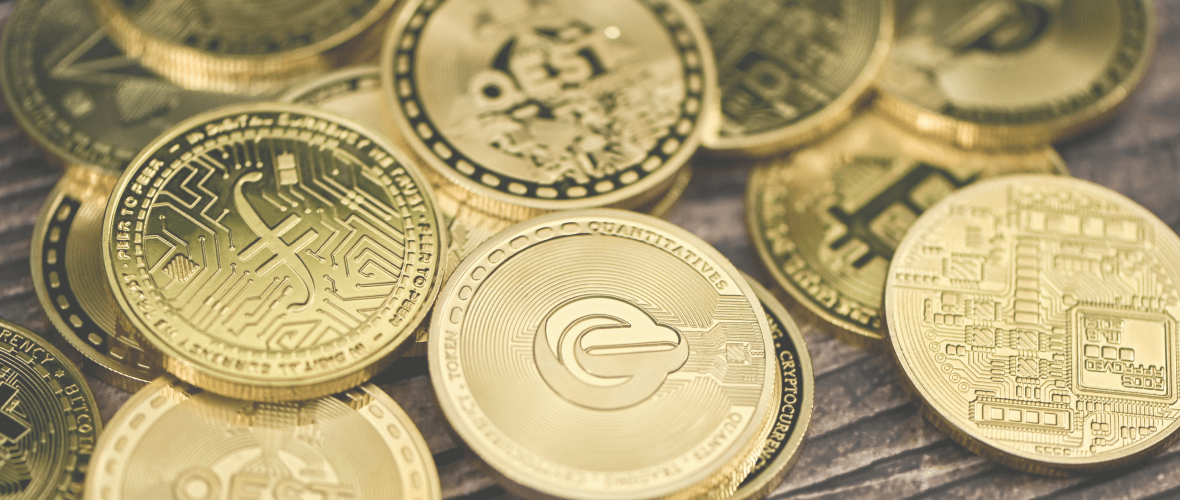Explore the world of altcoins, which go beyond Bitcoin and Ethereum in the cryptocurrency landscape. These unique and potentially impactful digital currencies offer more than just alternatives; they are innovative and can become key market players.
Exploring altcoins is about diversifying your crypto portfolio and discovering various digital currencies, from utility tokens to stablecoins. Each altcoin offers something unique for your investment strategy. Let’s see how these exciting coins can enhance your crypto portfolio. Plus, you’ll find out how Kriptomat’s large selection of cutting-edge trading tools can make your altcoin investing effortless.
What are altcoins?
Altcoins, short for ‘alternative coins’, are cryptocurrencies that were launched after the success of Bitcoin. While Bitcoin focuses on decentralised transactions and Ethereum on smart contracts, altcoins aim to fulfil specific roles or enhance cryptocurrency features. Their functions vary from governance and privacy to quick transactions and energy-efficient processes.
In altcoins, there’s a key difference between ‘coins’ and ‘tokens.’ Coins, like Bitcoin and Ethereum, have their own blockchains and act as digital money. Tokens, like Chainlink or Uniswap, are built on existing blockchains (like Ethereum) and often represent assets or utilities in a specific ecosystem. For example, a token might be used to access a service, represent a stake in a project, or even track real-world assets.
The history of altcoins began shortly after Bitcoin’s emergence, with Litecoin in 2011 being one of the first. These early altcoins typically sought to improve upon Bitcoin’s technology, offering faster transactions or more efficient mining processes. Over time, the scope of altcoins has broadened significantly, leading to the creation of thousands of different cryptocurrencies, each with unique features and uses. This evolution reflects the growing complexity and specialisation within the cryptocurrency space.
Learn more about coins and tokens in our beginner-friendly course “Introduction to cryptocurrencies”.
What are the different types of altcoins?
Altcoins, a diverse and innovative segment of the cryptocurrency market, can be broadly categorised into several types, each serving unique purposes and functions:
- Utility tokens: These tokens provide users with access to a product or service within a specific ecosystem. For example, Filecoin (FIL) offers decentralised storage solutions, while Chainlink (LINK) connects smart contracts with real-world data.
- Security tokens: Security tokens are digital assets that represent ownership in real-world assets, like stocks, bonds, or real estate. They often adhere to regulatory standards. An example is tZERO, which offers blockchain-based trading for various assets.
- Stablecoins: Designed to minimise price volatility, stablecoins are pegged to stable assets like fiat currencies or gold. Tether (USDT) and USD Coin (USDC) are prominent examples, often used to facilitate trading and maintain value stability in the crypto market.
- Governance tokens: These tokens give holders voting rights and influence over the development of a blockchain project. Maker (MKR) is a key example, allowing holders to vote on changes to the MakerDAO ecosystem.
- Privacy coins: Focused on enhancing transaction privacy and anonymity, privacy coins like Monero (XMR) and Zcash (ZEC) obscure transaction details to maintain user confidentiality.
- DeFi tokens: DeFi, or Decentralised Finance, tokens are part of financial services protocols. Examples include Aave (AAVE) and Compound (COMP), which are involved in lending and borrowing platforms.
- Meme coins: Initially created as jokes or with no serious purpose, meme coins like Dogecoin (DOGE) and Shiba Inu (SHIB) have gained significant popularity and market capitalization.
- Platform tokens: These are native tokens of blockchain platforms that facilitate the creation of decentralised applications (dApps) and smart contracts. Ethereum (ETH) is the most prominent example, though it’s often classified as a major cryptocurrency rather than an altcoin.
Each type of altcoin represents a unique aspect of the cryptocurrency world, from offering practical utility in digital ecosystems to representing digital governance and privacy. As the crypto landscape continues to evolve, these altcoins play a vital role in expanding the possibilities of blockchain technology and digital finance.
Explore how tokens can be used in various sectors with our course tailored to beginners “Crypto use cases”.
The role of altcoins in a balanced portfolio
Altcoins can significantly enhance a cryptocurrency portfolio by offering diversity in terms of growth potential, stability, and innovation. For instance, while some altcoins present high growth potential due to their innovative use cases and emerging technologies, others like stablecoins add an element of stability, offsetting the inherent volatility of the crypto market.
Investing in diverse altcoins lets investors explore various market segments and technologies. For instance, DeFi tokens provide access to decentralised finance, while privacy coins appeal to those seeking transaction anonymity. This diversification helps capitalise on unique altcoin opportunities and spreads risk across different assets.
Balancing altcoin investments means evaluating their risk-reward profiles and matching them with your goals and risk tolerance. A mix of established cryptocurrencies like Bitcoin and Ethereum, along with carefully chosen altcoins, creates a diverse, market-resilient portfolio ready to capitalise on different crypto trends.
Ready to master the art of a balanced crypto portfolio? Check out our guide “How to Build A Balanced Crypto Portfolio: Strategies for Risk Diversification” for expert tips on managing risk and diversifying your investments effectively.
How to evaluate altcoins for investment
When considering altcoins for investment, it’s crucial to conduct thorough research and evaluation. Start by examining the technology behind the altcoin. Is it innovative, and does it solve a particular problem in a unique way? Look into the development team’s expertise and track record. A strong, experienced team can be a good indicator of the project’s potential.
Market analysis is also key. Check the altcoin’s market capitalization, trading volume, and historical price trends. A higher market cap can indicate stability, but it’s also essential to consider the liquidity and potential for growth. Analyse the tokenomics – the total and circulating supply, and how the tokens are distributed.
Community support and ecosystem development are vital too. A vibrant and active community can be a sign of a healthy ecosystem. Lastly, understand the regulatory environment of the altcoin, as legal challenges can significantly impact its future.
By carefully evaluating these aspects, you can make more informed decisions and select altcoins that align with your investment strategy and risk tolerance.
Take your knowledge further with our comprehensive tutorial, “From Novice to Expert: Learn to Research Cryptocurrencies“. It will equip you with deeper insights and techniques for analyzing the crypto market effectively.
How to manage risk with altcoins
Investing in altcoins involves risks like high volatility, lower liquidity, and sensitivity to market sentiment. Newer or less-known altcoins can face sharp price swings due to speculative trading and hype. Their lower liquidity compared to major cryptocurrencies can also make large transactions more challenging without impacting market prices.
How can you mitigate these risks?
- Strategic portfolio allocation: Limit altcoins’ share in your portfolio to control volatility exposure. Distribute investments between well-known cryptocurrencies and altcoins.
- Diversify within altcoins: Spread the risk by investing in different types of tokens.
- Regular market analysis: Stay updated on altcoin developments, technology, regulations, and trends for timely investment adjustments.
- Leverage the power of Intelligent Portfolios: Kriptomat offers a revolutionary way to simplify your altcoin investing: Intelligent Portfolios. These portfolios use advanced technology to manage risk and optimise returns, making them ideal for diversifying your crypto investments. Explore our tutorial “Invest Smarter: How to Optimise Your Crypto Assets with Kriptomat’s Intelligent Portfolios” to see how Intelligent Portfolios can enhance your strategy, especially when dealing with altcoins.
The bottom line
Altcoins can significantly enrich your crypto portfolio, offering access to innovative technologies and diversification benefits. They allow you to explore various market segments, each with its unique potential. However, the success in altcoin investing hinges on thorough research and informed decision-making. Understanding each altcoin’s technology, market behaviour, and risks is crucial.
Kriptomat simplifies your journey into altcoins with its range of user-friendly tools and resources. Features such as Intelligent Portfolios assist in making well-informed decisions, enabling you to strategically navigate the altcoin landscape. We invite you to deepen your crypto knowledge with the extensive range of educational content on our site. With Kriptomat’s support, you can confidently build a diverse and resilient cryptocurrency portfolio, capitalising on the opportunities that altcoins present.
NOTE
This text is informative in nature and should not be considered an investment recommendation. It does not express the personal opinion of the author or service. Any investment or trading is risky, and past returns are not a guarantee of future returns. Risk only assets that you are willing to lose.




 IOS
IOS Android
Android